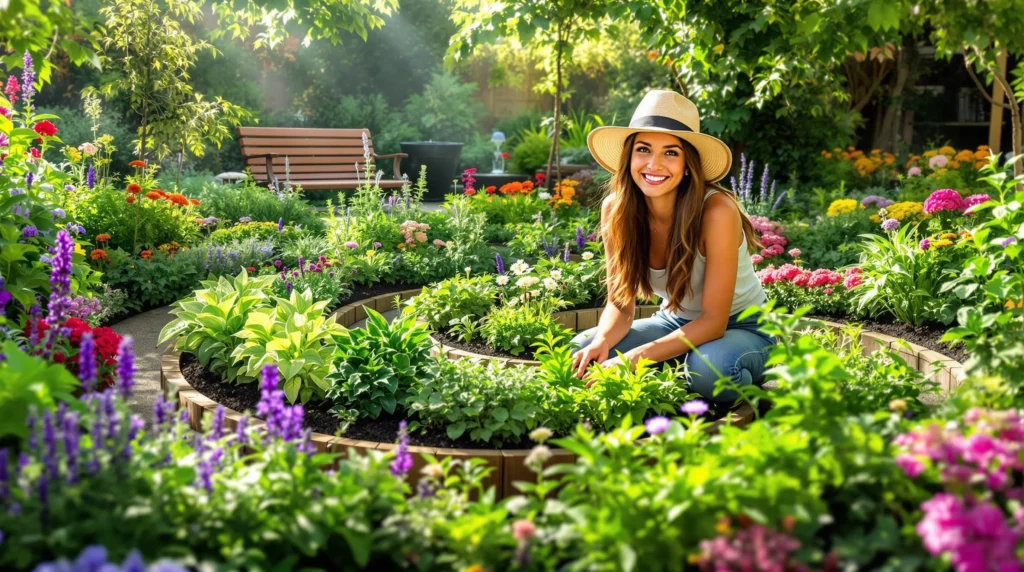Creating A Healing Herb Garden: Essential Planning Tips
Before planting your first medicinal herb, take time to carefully plan your healing garden for optimal growth and accessibility. Start by choosing a location that receives at least 6-8 hours of sunlight daily, as most medicinal herbs thrive in full sun. Test your soil’s pH level (most herbs prefer slightly acidic to neutral soil between 6.0-7.0) and enrich it with organic compost to improve drainage and nutrient content. Create a garden layout that groups herbs with similar water and light requirements together—place drought-tolerant herbs like rosemary and thyme in one section, while moisture-loving plants like mint and lemon balm in another. Consider accessibility by installing raised beds or container gardens if you have mobility concerns, and incorporate stepping stones or paths between plantings for easy harvesting. Remember to leave adequate spacing between plants (typically 12-18 inches apart for most herbs) to allow for proper air circulation and growth. Finally, install a simple irrigation system like soaker hoses to ensure consistent watering, especially crucial during the establishment phase of your healing herb garden.
10 Medicinal Herbs To Include In Your Healing Garden
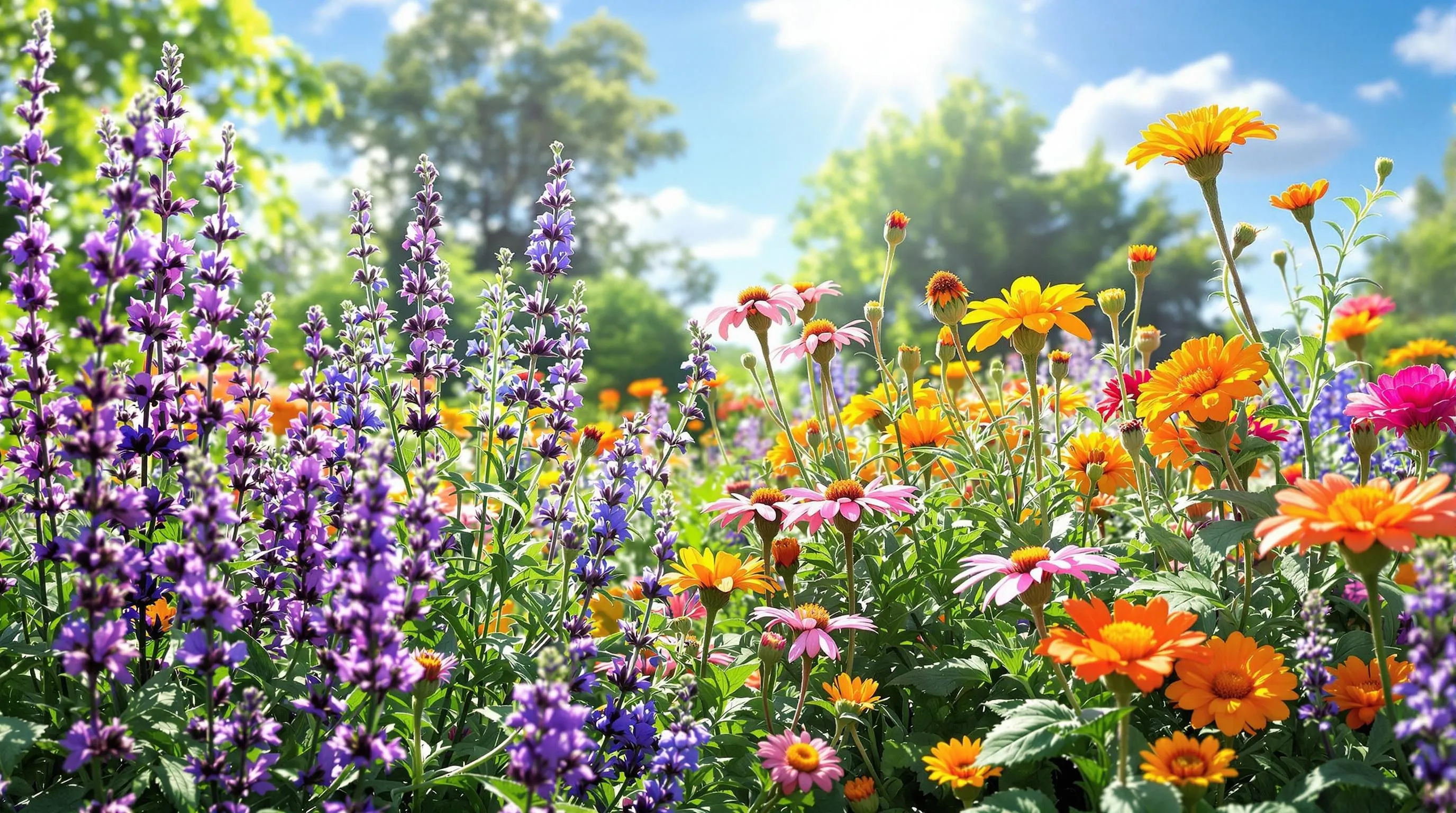
These powerful medicinal herbs are perfect additions to your healing garden, combining beauty with therapeutic benefits. Each plant offers unique healing properties that have been utilized for centuries in traditional medicine systems worldwide.
Calming Lavender For Stress Relief
Lavender (Lavandula angustifolia) stands as one of the most versatile medicinal herbs for your garden. This aromatic perennial produces beautiful purple flowers and contains compounds that reduce anxiety, promote relaxation, and improve sleep quality. Plant lavender in well-draining soil with full sun exposure. Harvest the flower spikes just as they begin to open for the strongest essential oil content. You can use dried lavender in sachets, teas, or infused oils to calm your nervous system after stressful days.
Immune-Boosting Echinacea
Echinacea purpurea (Purple Coneflower) offers stunning pink-purple blooms while providing powerful immune system support. This native perennial contains active compounds that stimulate white blood cell production and fight infections. Grow echinacea in moderately rich, well-draining soil with at least 6 hours of sunlight daily. Harvest the roots after 2-3 years of growth and the flowers when fully open. Prepare the roots as tinctures or dried for teas to help combat colds and flu symptoms naturally.
Digestive Aid Peppermint
Peppermint (Mentha piperita) serves as an excellent digestive remedy with its cooling menthol properties. This vigorous herb reduces stomach discomfort, eases nausea, and alleviates IBS symptoms. Plant peppermint in containers to prevent spreading, as it grows aggressively through underground runners. Position in partial shade with consistent moisture. Harvest leaves before flowering for the highest essential oil concentration. Fresh peppermint leaves can be chewed directly for immediate digestive relief or prepared as tea for stomach complaints.
Anti-Inflammatory Turmeric
Turmeric (Curcuma longa) contains curcumin, a powerful anti-inflammatory compound that reduces joint pain and supports overall cellular health. This tropical plant with vibrant yellow rhizomes thrives in warm, humid climates (zones 8-11) or can be grown indoors in cooler regions. Plant turmeric in rich, well-draining soil and provide consistent moisture and partial shade. Harvest the rhizomes after 8-10 months when the leaves begin to yellow. Grate fresh turmeric into foods or dry and powder it for cooking and medicinal preparations.
Sleep-Improving Chamomile
German chamomile (Matricaria recutita) produces delicate daisy-like flowers with potent sleep-inducing and anxiety-reducing properties. This annual herb contains apigenin, which binds to brain receptors to reduce insomnia and promote relaxation. Sow chamomile seeds in spring in well-draining soil with full sun to partial shade. Harvest the flowers when fully open but before they begin to wilt. Dry the flower heads for calming bedtime teas that improve sleep quality and reduce nighttime waking.
Healing Calendula For Skin Care
Calendula (Calendula officinalis) offers bright orange and yellow flowers packed with skin-healing compounds. This annual herb contains anti-inflammatory, antimicrobial, and wound-healing properties that treat cuts, burns, and skin irritations. Plant calendula in average soil with full sun, where it will bloom continuously from spring until frost. Harvest the flower heads regularly to encourage more blooms. Infuse the petals in oil to create healing salves and ointments for external application on minor wounds and irritated skin.
Heart-Healthy Hawthorn
Hawthorn (Crataegus species) supports cardiovascular health with its berries, flowers, and leaves. This small tree or shrub contains antioxidants that strengthen heart muscle, improve blood flow, and regulate blood pressure. Plant hawthorn in full sun to partial shade in well-draining soil. Harvest berries in fall when fully ripe and flowers in spring. Prepare the berries as tinctures or syrups for long-term heart health support under proper medical supervision.
Liver-Supporting Milk Thistle
Milk thistle (Silybum marianum) contains silymarin, a powerful liver-protective compound that detoxifies and regenerates liver cells. This striking biennial features spiny leaves with distinctive white marbling and purple flower heads. Grow milk thistle in poor to moderate soil with full sun exposure. Harvest the seeds when the fluffy white pappus appears. Grind the seeds to make liver-supporting teas or tinctures that aid in natural detoxification processes.
Respiratory Helper Thyme
Thyme (Thymus vulgaris) serves as a potent respiratory aid with its antimicrobial essential oils that fight respiratory infections and relieve coughs. This low-growing perennial creates an attractive groundcover with tiny fragrant leaves and small purple flowers. Plant thyme in lean, well-draining soil with full sun. Harvest stems just before flowering for the highest concentration of active compounds. Use fresh or dried thyme in steam inhalations or teas to clear congestion and soothe irritated airways.
Brain-Boosting Rosemary
Rosemary (Rosmarinus officinalis) enhances memory and cognitive function while providing antioxidant benefits. This woody perennial contains compounds that improve blood circulation to the brain and support neural health. Grow rosemary in well-draining, slightly alkaline soil with full sun. Harvest small branches throughout the growing season as needed. Infuse fresh rosemary in hot water as an invigorating tea to sharpen mental focus or use the essential oil for aromatherapy to boost concentration during demanding tasks.
Designing Your Healing Herb Garden Layout
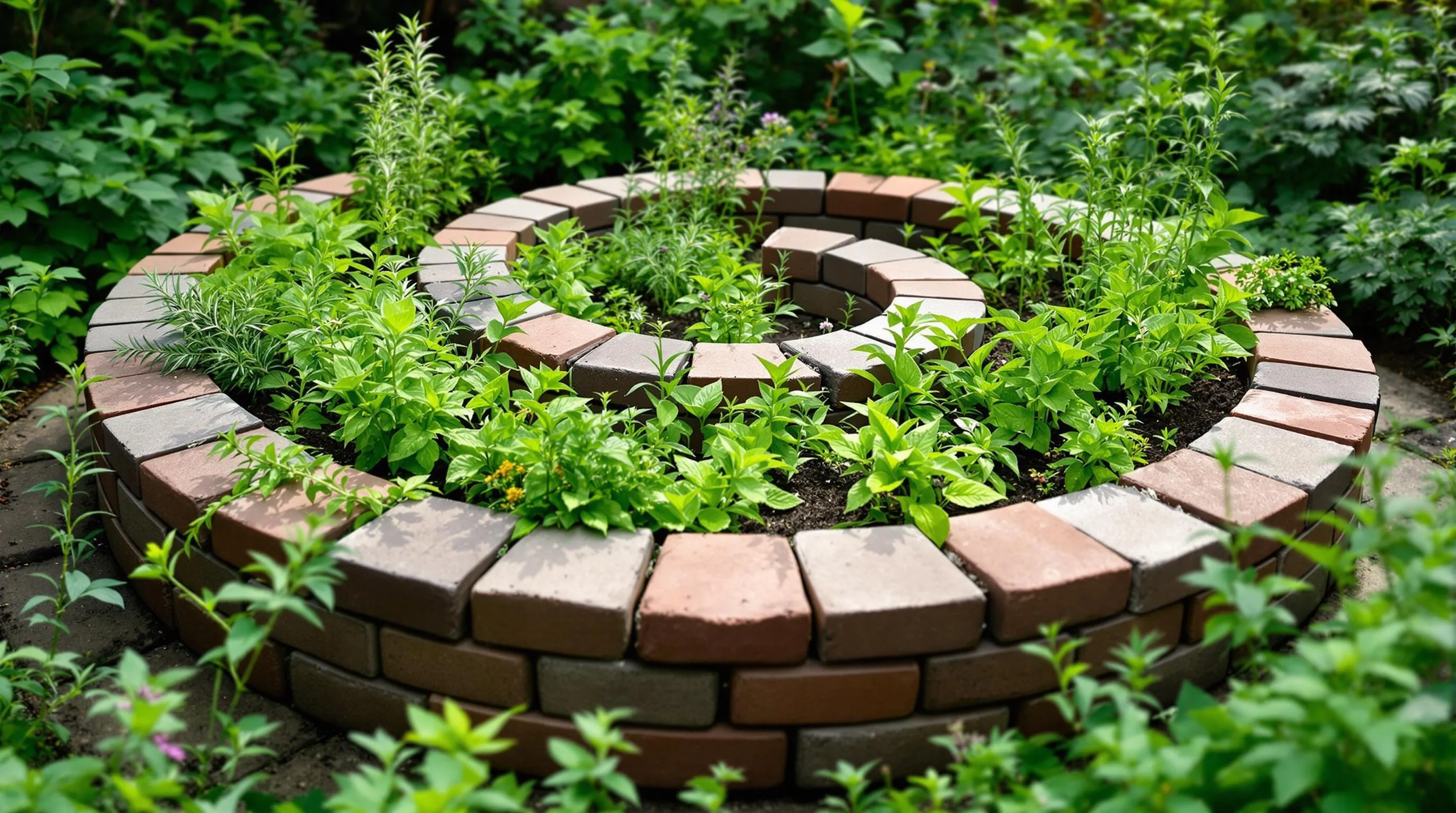
Creating an effective layout for your healing herb garden maximizes both functionality and therapeutic benefits. Strategic design ensures your medicinal plants thrive while creating a space that’s both beautiful and practical.
Spiral Garden Designs For Maximum Space Utilization
Spiral herb gardens offer an ingenious solution for growing multiple varieties in a compact area. This ancient permaculture technique creates microclimates within a single structure, allowing you to plant herbs with different sunlight and moisture requirements in one cohesive design. The elevated center receives maximum sun exposure—perfect for Mediterranean herbs like rosemary and thyme—while lower areas retain more moisture for plants like mint and lemon balm. Build your spiral using stones, bricks, or recycled materials in a 5-6 foot diameter, starting with a 3-foot height at the center that gradually slopes downward. This design not only maximizes growing space but also creates an eye-catching focal point that improves accessibility during harvesting and maintenance.
Raised Bed Gardens For Accessibility
Raised bed gardens eliminate bending and stooping, making herb gardening accessible for all gardeners regardless of mobility limitations. Construct beds 24-30 inches high and 3-4 feet wide to ensure easy reach from all sides without straining. Cedar, redwood, or composite materials offer durability without leaching harmful chemicals into your medicinal plants. Divide your raised beds into sections based on plant families or growing requirements—grouping Mediterranean herbs like sage and oregano in one section and moisture-loving herbs like mint and lemon balm in another. This organization improves plant health while creating logical harvest zones. Include pathways at least 36 inches wide between beds to accommodate wheelchairs or garden tools, and consider adding a ledge around the perimeter for comfortable seating during maintenance tasks.
Vertical Herb Gardens For Small Spaces
Vertical herb gardens transform limited areas into productive growing spaces by utilizing walls, fences, and upright structures. Install tiered planters, wall-mounted pockets, or repurposed pallets to grow medicinal herbs without consuming valuable ground space. Place sun-loving herbs like echinacea and lavender at the top levels where they’ll receive maximum light, while positioning shade-tolerant herbs like mint and lemon balm on lower tiers. Ensure your vertical structure can support the weight when plants are fully grown and soil is saturated—typically 20-30 pounds per square foot. Incorporate a drip irrigation system with a timer to maintain consistent moisture levels throughout the vertical plane, as upper sections tend to dry faster than lower ones. This space-saving approach works particularly well for apartment balconies, small patios, or urban gardens where ground space is limited but walls are abundant.
Container Garden Ideas For Healing Herbs
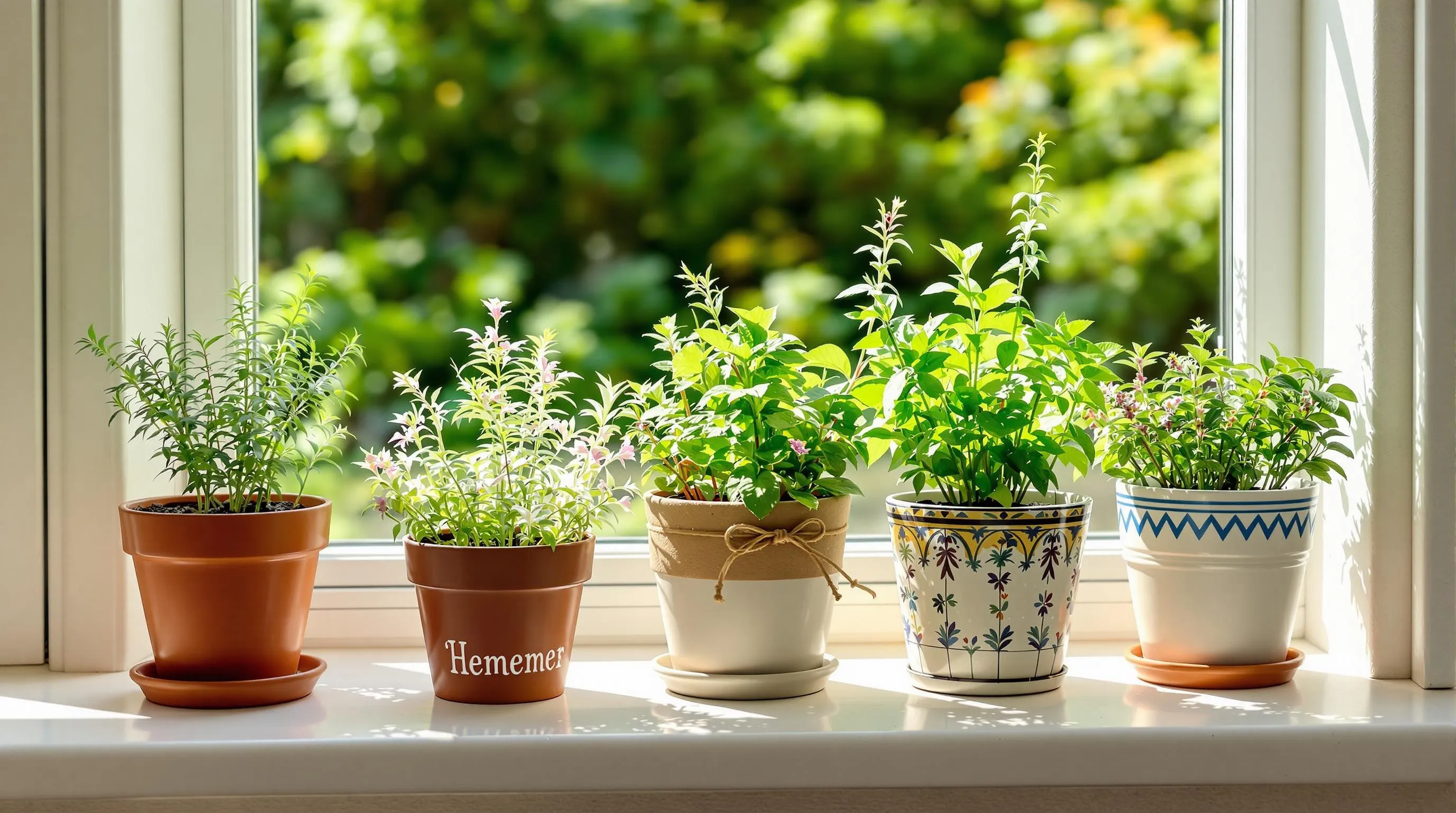
Container gardening offers flexibility and accessibility for growing medicinal herbs regardless of your space limitations. These portable mini-gardens allow you to cultivate healing plants even without a traditional garden plot.
Window Box Arrangements For Kitchen Access
Window boxes provide the perfect solution for growing essential healing herbs right where you’ll use them most—your kitchen. Install sturdy boxes on exterior windowsills or indoor shelving near bright windows to create an accessible herb collection. Plant compact varieties like thyme, oregano, mint, and chamomile that thrive in confined spaces. Arrange taller herbs like rosemary toward the back and trailing varieties like creeping thyme toward the front for visual interest. The proximity to your kitchen means you’ll be more likely to harvest fresh herbs regularly for both culinary and medicinal purposes. Choose window boxes with proper drainage holes and use lightweight, well-draining potting soil specifically formulated for herbs to ensure optimal growth.
Portable Pot Gardens For Seasonal Adjustments
Create a flexible healing herb garden using individual pots that can be relocated as seasons change. Select containers of various sizes—larger pots (12+ inches) for perennials like echinacea and lavender, medium pots for lemon balm and sage, and smaller vessels for annual herbs. Group pots together on wheeled plant caddies or decorative trays for easy movement to follow sunlight patterns or protect from harsh weather. This mobility allows you to bring tender medicinal herbs indoors during winter while keeping hardier varieties outside. Use terracotta pots for herbs that prefer drier conditions like rosemary and thyme, and glazed ceramic pots for moisture-loving herbs like mint and bee balm. The portability of this arrangement lets you optimize growing conditions year-round while maintaining convenient access to your healing herbs.
Combining Healing Herbs With Companion Plants
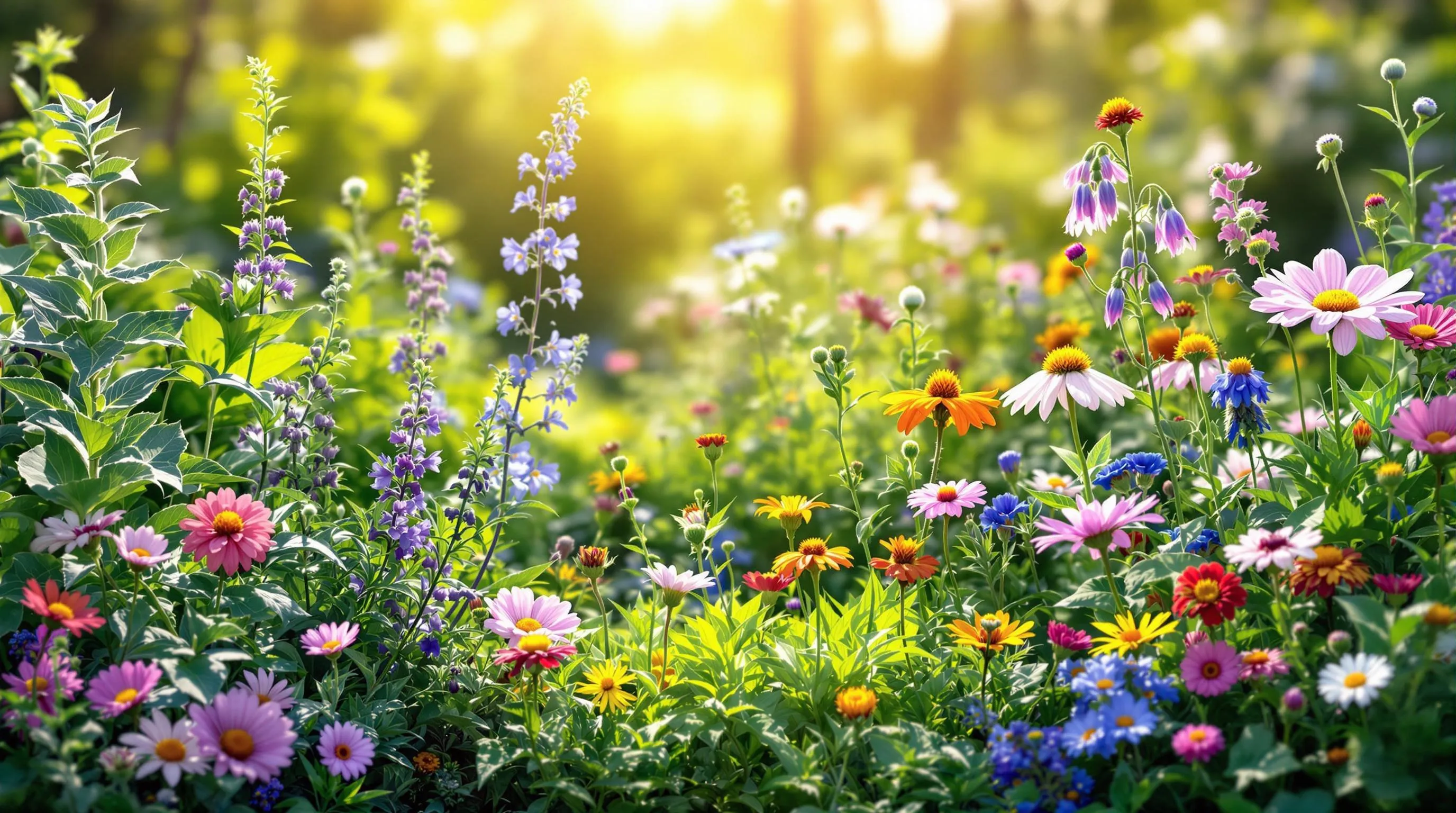
Companion planting is a time-tested gardening strategy that maximizes your healing herb garden’s potential by creating beneficial plant relationships. When you thoughtfully pair medicinal herbs with complementary plants, you’ll enhance growth, improve flavor profiles, and naturally deter pests without harsh chemicals.
Beneficial Insect-Attracting Companions
Attracting helpful insects is essential for a thriving healing herb garden. Plant borage near medicinal herbs like sage and thyme to draw pollinators that increase herb yield by up to 30%. Nasturtiums serve as sacrificial plants, luring aphids away from valuable herbs like echinacea and mint. Yarrow attracts predatory wasps and ladybugs that target common herb pests such as aphids and caterpillars. Cosmos flowers, with their bright blooms, bring in beneficial hover flies that consume up to 150 aphids per day, protecting your calendula and chamomile. Consider planting sweet alyssum as ground cover between herb rows—its tiny flowers attract minute pirate bugs that feed on thrips and spider mites threatening your medicinal plants.
Flavor-Improving Plant Pairings
Strategic plant combinations can significantly improve the potency and flavor of your healing herbs. Basil planted alongside holy basil (tulsi) intensifies the medicinal properties of both plants while creating a stress-relieving corner in your garden. Pairing rosemary with sage enhances the antioxidant levels in both herbs—studies show up to 15% increased essential oil production when grown together. Planting lemon balm near mint creates a synergistic effect that amplifies their calming properties while preventing mint from aggressively spreading. Try growing chives near thyme to naturally boost thyme’s throat-soothing compounds while adding pest resistance. For digestive herbs like fennel, plant it near dill and cilantro to create a comprehensive digestive support section with improved flavor complexity.
Maintaining Your Healing Herb Garden Year-Round
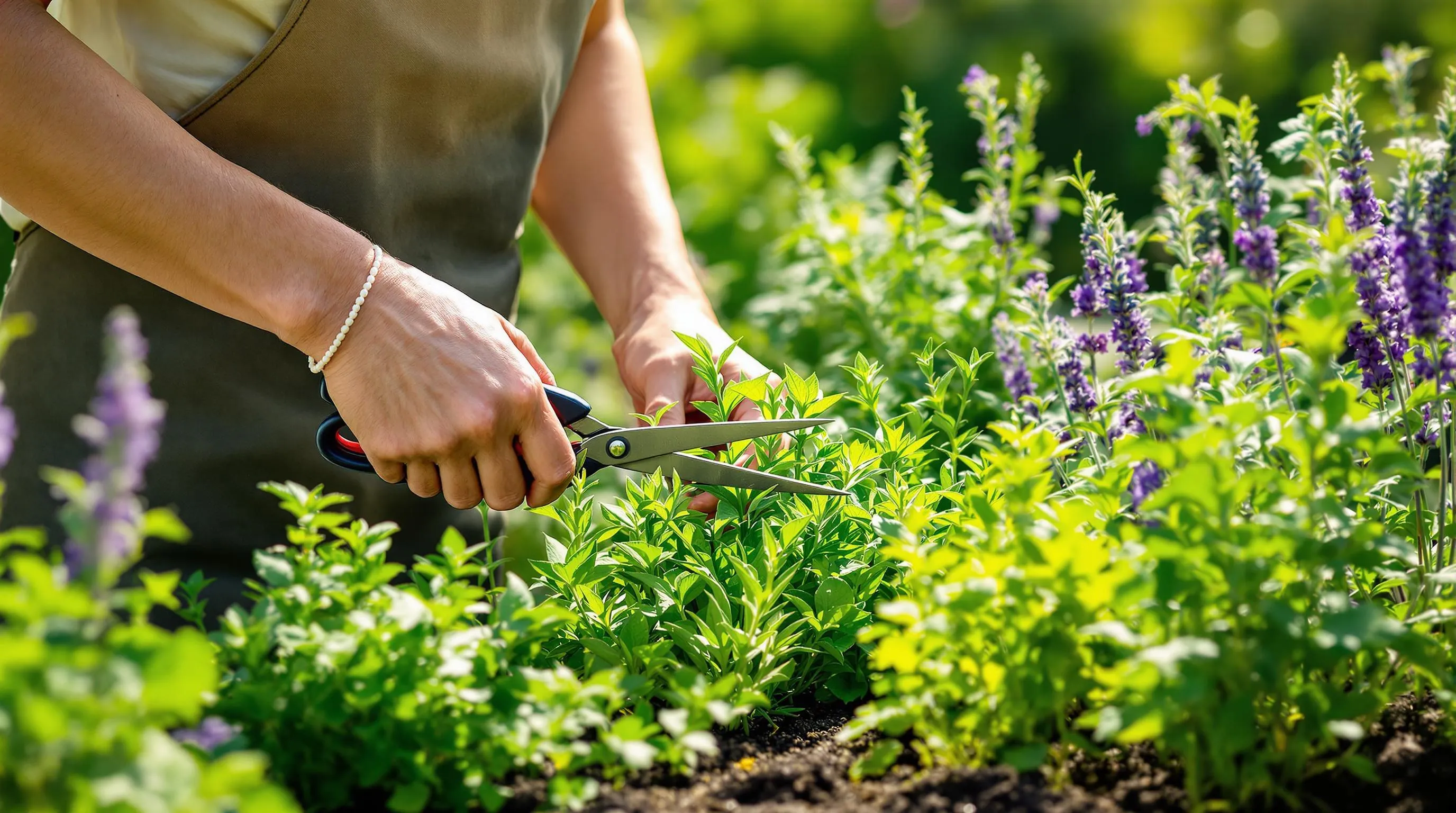
A thriving healing herb garden requires consistent care throughout the seasons to ensure your medicinal plants remain productive and healthy. With proper maintenance techniques, you’ll enjoy a continuous supply of healing herbs regardless of the season.
Seasonal Harvesting Techniques
Harvesting your medicinal herbs at the right time maximizes their healing properties and ensures continuous growth. During spring, harvest young leaves sparingly to allow plants like mint and lemon balm to establish themselves. Summer brings peak potency for most herbs—collect flowers like calendula and chamomile in mid-morning after dew has dried but before the hot sun depletes their essential oils. For leafy herbs such as basil and oregano, pinch just above a leaf node to encourage bushier growth. Fall harvesting should focus on gathering seeds from echinacea and dill, while roots from plants like valerian are best harvested in late fall after the first frost when their energy concentrates below ground. Winter offers limited outdoor harvesting opportunities, but indoor herbs like rosemary and thyme can be lightly trimmed year-round. Always use clean, sharp scissors to minimize stress on the plants and store harvested herbs properly to preserve their medicinal value.
Proper Pruning Methods For Continued Growth
Regular pruning keeps your healing herbs vibrant and productive throughout the year. Remove no more than one-third of perennial herbs like lavender and sage during any pruning session to prevent shock. Make clean cuts just above leaf nodes or growth points to stimulate branching and create fuller plants. Deadhead spent flowers from echinacea, calendula, and chamomile to extend blooming periods and prevent excessive self-seeding. For woody herbs such as rosemary and thyme, avoid cutting into old wood that lacks leaves as these sections rarely regenerate. Mint family herbs benefit from aggressive pruning to control their spreading habit and maintain vigor. During winter, reduce pruning to minimal maintenance for outdoor perennials, focusing instead on indoor herbs that continue active growth. Remove any diseased or damaged portions immediately regardless of season to prevent issues from spreading. Strategic pruning not only shapes your plants but also improves air circulation, reducing fungal problems that can compromise your herbs’ medicinal qualities.
DIY Herb Garden Projects With Healing Benefits
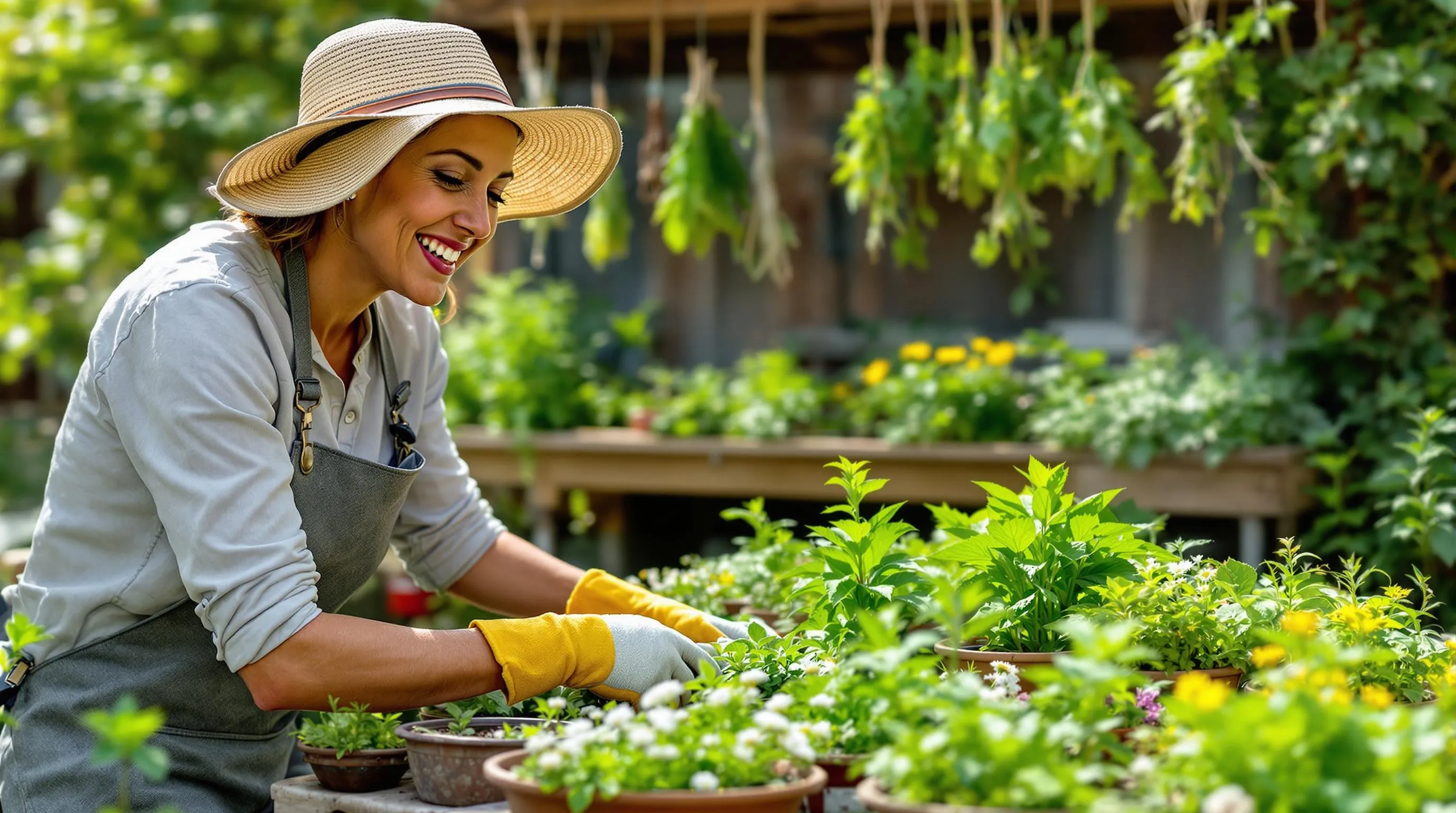
Transform your gardening experience with these hands-on projects that enhance both the functionality of your healing herb garden and your connection to medicinal plants.
Creating A Tea Garden Section
Design a dedicated tea garden section to grow herbs specifically for brewing healing teas. Plant chamomile, mint, lemon balm, and holy basil in a designated area with easy access for frequent harvesting. Arrange your tea herbs in a circular pattern with taller plants like lemongrass in the center and lower-growing herbs like thyme around the edges. Add stepping stones between plant groupings to make harvesting comfortable without compacting the soil. Consider labeling each herb with small stakes indicating their exact health benefits—mint for digestion, chamomile for sleep, and lemon balm for anxiety relief. This purposeful design creates not only a functional space but also a meditative area where you can connect with the healing properties of your plants before they even reach your teacup.
Building A Medicinal Herb Drying Station
Create a practical herb drying station to preserve your medicinal herbs at peak potency. Start with a simple wooden frame using untreated lumber, then stretch and secure food-grade mesh or cheesecloth across it for proper air circulation. Hang this frame in a warm, dry location away from direct sunlight, such as a spare closet, attic space, or covered porch. For smaller spaces, install a multi-tiered hanging system using embroidery hoops with mesh screens attached to strings at different heights. Add small labels to identify each herb and its harvest date to track drying times. This DIY drying station allows you to extend the healing benefits of your garden year-round by properly preserving herbs with their medicinal compounds intact, ensuring you’ll have access to homegrown remedies throughout the seasons.
Therapeutic Garden Features To Enhance Healing Properties

A healing herb garden becomes truly groundbreaking when designed with elements that amplify its therapeutic benefits. These intentional features create a holistic healing environment that engages all senses and promotes well-being.
Adding Water Elements For Tranquility
Water features bring an unmatched sense of tranquility to your healing herb garden. Install a small fountain to create gentle, soothing sounds that mask urban noise and induce relaxation. The flowing water also attracts beneficial wildlife like birds and butterflies, adding movement and life to your garden. Consider adding a shallow basin or bird bath near calming herbs like lavender or lemon balm to create a multi-sensory healing zone. Even a small tabletop fountain can dramatically enhance your garden’s therapeutic properties by increasing humidity for moisture-loving herbs while providing the documented stress-reducing benefits of water sounds. Position these elements where you can easily see and hear them from your primary relaxation areas.
Incorporating Seating Areas For Meditation
Strategic seating transforms your healing herb garden into a true sanctuary for mindfulness and meditation. Place comfortable benches or chairs amid fragrant herbs like rosemary and sage where their aromatic oils can be fully experienced during quiet moments. Create a dedicated meditation nook surrounded by tall, protective plants like holy basil or lemon verbena that provide privacy and a sense of enclosure. Use natural materials like stone, wood, or bamboo for seating to maintain harmony with the garden’s organic elements. Position seating to capture morning or evening light depending on when you’ll most likely use the space. This intentional design encourages you to pause regularly among your healing plants, absorbing their benefits through all senses while promoting mindfulness and reducing stress through contemplative practice.
Harvesting And Using Your Healing Herbs
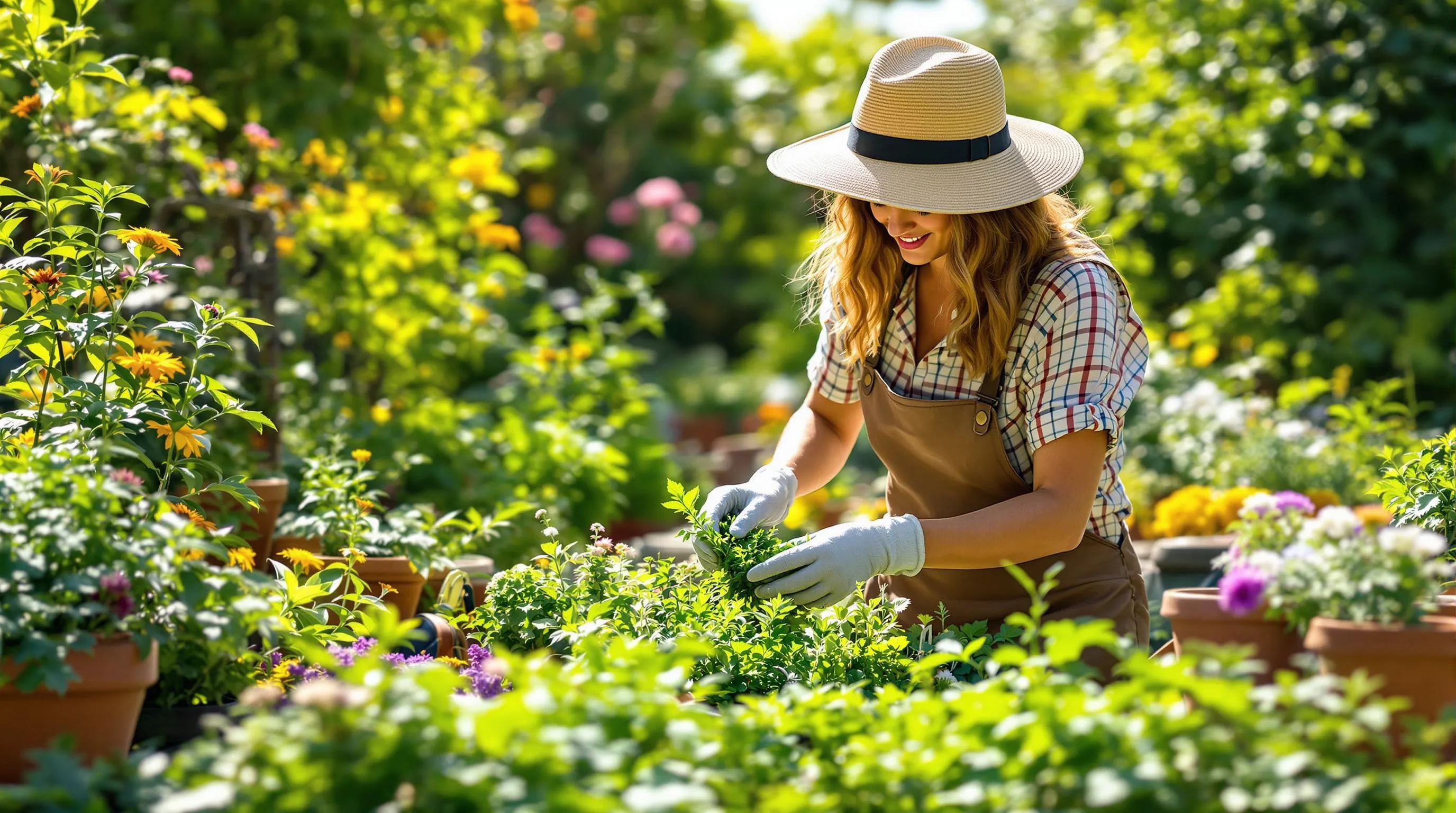
Harvesting your medicinal herbs at the right time ensures maximum potency and therapeutic benefits. The journey from garden to medicine cabinet requires proper techniques and timing to preserve the healing properties of your plants.
Making Tinctures And Salves
Transform your healing herbs into powerful tinctures and salves for long-term use and targeted applications. To create tinctures, harvest herbs mid-morning after dew has dried but before the hot sun depletes their essential oils. Chop fresh herbs like echinacea root, St. John’s wort, or calendula flowers, then submerge them in 80-100 proof alcohol at a 1:2 ratio of plant material to liquid. Store in amber glass bottles in a cool, dark place for 4-6 weeks, shaking daily. Strain through cheesecloth and transfer to dropper bottles for easy dispensing. For healing salves, infuse herbs like comfrey, plantain, or lavender in carrier oil (olive or coconut) by gentle heating for 2-3 hours, then strain and add beeswax (1 part wax to 4 parts oil) to solidify. Pour into small tins while still warm and allow to cool completely before sealing. Label both preparations with ingredients and creation dates for proper tracking.
Creating Healing Herb Teas And Infusions
Create therapeutic teas and infusions from your garden’s bounty for immediate relief and daily wellness support. Harvest leaves and flowers in mid-morning when their essential oil content peaks, and roots in fall when their medicinal compounds are most concentrated. For fresh herb tea, use 1 tablespoon of chopped herbs per cup of water—chamomile for sleep support, peppermint for digestion, or lemon balm for anxiety relief. Pour just-boiled water over herbs and steep covered for 5-10 minutes to prevent volatile oils from escaping. For stronger medicinal infusions, use 1 ounce of dried herbs per quart of water and steep for 4-8 hours in a covered container. Strain carefully and store refrigerated for up to 3 days. Create custom blends based on your health needs, such as combining elderflower, yarrow, and peppermint for cold and flu support. Always start with small amounts when trying new herbal preparations to test for individual sensitivities.
Conclusion: Embracing The Benefits Of Your Healing Herb Garden
Your healing herb garden offers more than just beautiful plants—it’s a gateway to holistic wellness right at your doorstep. By thoughtfully selecting medicinal herbs designing an accessible layout and implementing companion planting you’re creating a living pharmacy that connects you to centuries of herbal wisdom.
Remember that your garden will evolve with the seasons requiring different care throughout the year. As you harvest dry and transform your herbs into tinctures teas and salves you’ll develop a deeper appreciation for these powerful plants.
Whether you’ve created a spiral garden installed raised beds or simply arranged containers on your windowsill your healing herb garden serves as both a therapeutic sanctuary and a practical resource for natural remedies. The journey of tending to these plants is itself a healing practice that nourishes body mind and spirit.

